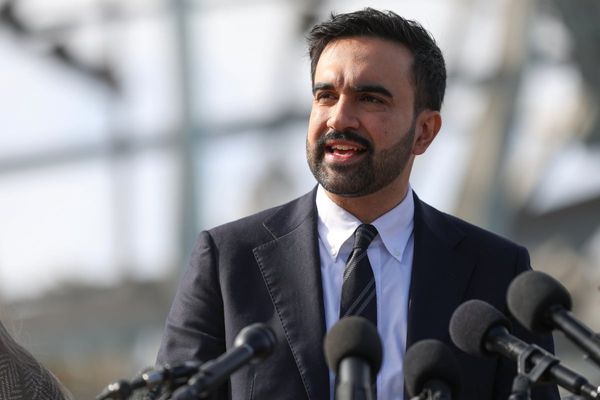On the campaign trail in a southwestern Arizona swing district, Democrat JoAnna Mendoza often recounts her hardscrabble upbringing.
She began working alongside her farmworker parents, clearing weeds from the cotton fields, when she was still in grade school. Her family relied on government aid and food banks. She joined the military at 17, partly as a way to escape poverty.
“I carry that struggle with me to this day,” said Mendoza, a 49-year-old single mother who is challenging Republican Rep. Juan Ciscomani in the 6th District. “I have not forgotten my roots and there are a lot of folks out there like me who have very similar stories.”
As Democrats chart a course out of the wilderness following steep 2024 losses, the party is counting on candidates from blue-collar backgrounds to win back working-class voters anxious about the high cost of living and angry at a political class they view as indifferent to their day-to-day difficulties.
In fact, brawny guys with progressive politics, anti-establishment swagger and a toughness born of adversity — not to mention an affinity for tattoos, beards and flannel — are having a moment in the run-up to the midterm elections.
But on the other side of the gender divide, Mendoza and a handful of Democratic female candidates also are building campaigns around economic populism rooted in humble origin stories and blue-collar backgrounds.
“You don’t have to have a beard in order to connect with voters,” said Jessica Mackler, the president of EMILY’s List, which backs Democratic women who support abortion rights. Voters, she added, are looking for “people who understand their lived experiences and are ready to fight back.”
A decisive demographic
Every election cycle has its coveted demographic: The 2018 midterms during Donald Trump’s first term saw suburban moderates power a blue wave that propelled a group of centrist women with national security backgrounds to victory.
This time, it’s working-class voters. Long a core Democratic constituency, they drifted to the right in 2016. The shift ramped up in 2024, when Trump received the backing of 66 percent of white voters without college degrees, according to an analysis of exit polls conducted by the Center for Politics at the University of Virginia.
Trump also performed particularly well among men, winning 55 percent of the male vote compared with his 46 percent support among women, a study by the Pew Research Center found.
The blue-collar Democratic men running in some of the nation’s most competitive House and Senate races are trying to break the GOP’s hold on working-class voters by playing up their unvarnished gruffness and embracing populist policies rooted in their lived experience. Many of them are political outsiders who have shown an eagerness to buck their party’s leaders.
There’s Graham Platner, an oyster farmer from Maine who deployed to Iraq and Afghanistan and is waging a populist campaign to unseat Republican Sen. Susan Collins. There’s Bob Brooks, who held a series of low-wage jobs – delivering pizzas, tending bar and working in a warehouse among them – before becoming a firefighter and launching a bid to unseat GOP Rep. Ryan Mackenzie in Pennsylvania’s Lehigh Valley. And there’s Nathan Sage, a former mechanic and Marine and Army veteran who grew up in a trailer park and is seeking the Senate seat Iowa Republican Joni Ernst is vacating.
Others who fit the mold include Dan Osborn, an industrial mechanic who led a strike at the Kellogg’s cereal plant and is running as an independent against Nebraska Republican Sen. Pete Ricketts, and former Secret Service agent Logan Forsythe, a Democrat seeking an open Senate seat in Kentucky, who picked tobacco at age 7 and taught himself to repair engines at 13.
“We’re in this moment where there’s obviously a kind of a hypermasculinity to a lot of the messaging,” said Jean Sinzdak, the associate director at the Center for American Women and Politics.
A message that resonates
Just like their male counterparts, this cycle’s cadre of Democratic blue-collar women are aiming for authenticity while pushing a message that the economy is stacked against working people.
Francesca Hong is a Wisconsin state representative, a single mother and a restaurant worker who’s campaigning for governor on a populist plank. Known for her outspoken, and occasionally profanity-laced, social media posts, Hong said she’s running to “fix a rigged system that puts oligarchs over workers and small businesses.”
Across the state line in Minnesota, flight attendant, state representative and single mother Kaela Berg is striking a similar theme.
“I know what it’s like to live paycheck to paycheck, to worry about rent, to go through a global pandemic without health care, and to fight for my son in a school system stretched too thin,” Berg said in announcing a House campaign for an open battleground Twin Cities district.
At a time of rising inflation and deep insecurity over the economy, such approaches are more likely to resonate with voters, Sinzdak said.
“Women from working-class backgrounds really speak to a particular set of voters in a big way, because they can speak authentically about their experience [and] their economic vision,” Sinzdak said.
And women are often the ones handling household budgets and arranging care for children and aging parents, “so they really understand these financial pressures,” Mackler said.
Or, as Mendoza puts it, “they’re pissed, and they’re scared, and they’re stressed out.”
Former Rep. Deb Haaland, who served as Joe Biden’s Interior secretary and is now running for governor of New Mexico, said economic concerns are front and center for voters.
“Affordability is one of the big issues, with all the tariffs and the price of groceries really going up,” she said. “I understand what it’s like for people when they say it’s hard to make ends meet. I understand what it’s like for them if they have to put groceries back at the checkout line because they don’t have the money to pay for them.”
Haaland is open about her own past economic struggles.
“I raised my kids as a single mom. I struggled to make ends meet. I know what it’s like to be on SNAP benefits, and I was able to give birth to my child because of Medicaid,” she said, adding that, at 64, she has yet to fully pay off her student loans.
Building their ranks
Working-class women remain underrepresented in Congress. But in recent years, two have found success, albeit from opposite points on the Democratic Party’s ideological spectrum: New York Rep. Alexandria Ocasio-Cortez, a former bartender and server and an outspoken progressive, and Washington Rep. Marie Gluesenkamp Pérez, the co-owner of an auto repair shop and a political moderate.
Despite the growing prominence of working-class candidates, some Democrats say party leadership has been too cautious in their recruiting efforts — and too willing to reject those from unconventional backgrounds.
Democrats “do a lot of credentialing around who can raise the most money or what your networks are,” said Rebecca Cooke, a Democrat making her third attempt to flip a pivotal Wisconsin district currently held by Republican Derrick Van Orden, “when we should be asking what kind of candidates are most representative of the districts.
Cooke, who grew up on an Eau Claire dairy farm and paid for college by patching together tuition payments from Pell Grants and scholarships and holding multiple jobs, lamented the low numbers of candidates with blue-collar roots.
“Why don’t we have 50 candidates from working-class backgrounds?” she said. “We need more people who are going to stand up to the ultra-wealthy.”
The post 2026 could be breakout year for blue-collar Democratic women appeared first on Roll Call.







